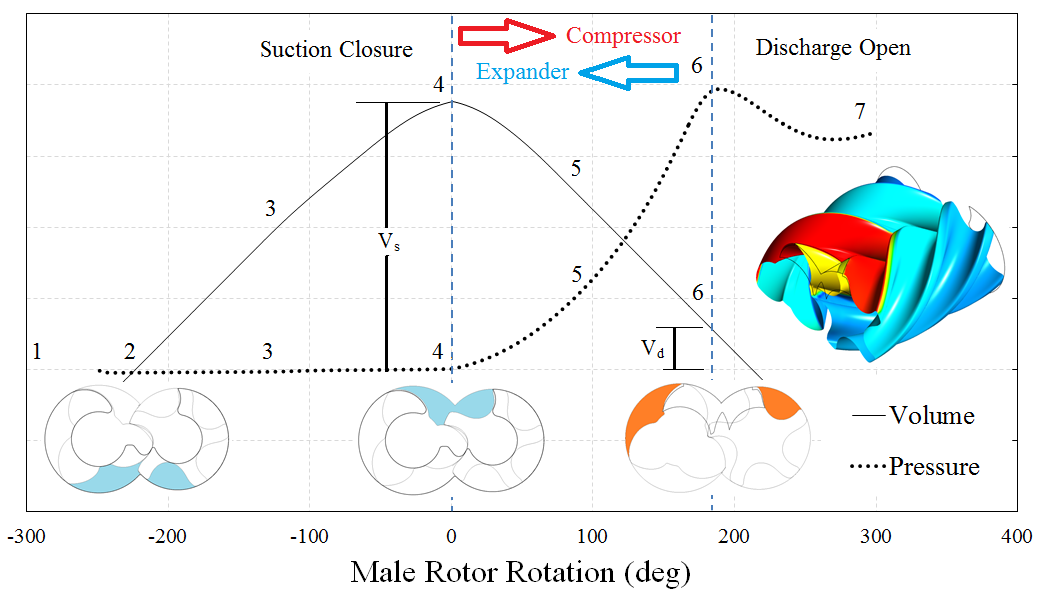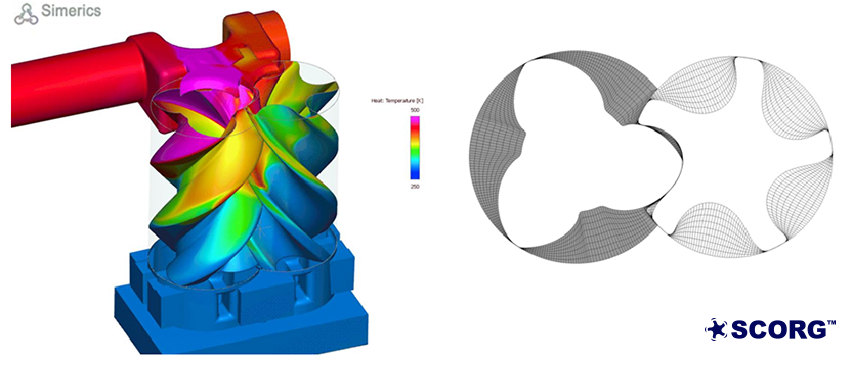


Screw Compressors are rotary positive displacement machines. Although the working principle of these machines is simple, the geometry of rotors which are in the form of multi-lobe helical screws meshing with each other is analysed by the use of Computational Fluid Dynamics challenging. The process starts when the lobes are engaged at one end, which increases the volume between the rotors and the casing, reducing pressure in the suction domain and drawing the working fluid in. Further rotation of the rotors makes this volume between the rotors and the case enclosed when fluid compression begins. This increases the pressure within the chamber. Finally, further rotation exposes the pressurised fluid to the outlet port, and the fluid is delivered.
A similar process occurs in other helical screw machines such as pumps, vacuum pumps, gear pumps, expanders, extruders and motors. CFD analysis is equally challenging in such machines due to sliding and stretching.
The main objectives of CFD simulations of a screw compressor are to:
- Obtain the pressure field inside the rotor chamber and in the suction and discharge domains.
- Obtain the velocity fields in critical regions of the computational domain.
- Obtain temperature fields in critical regions of the computational domain.
- Obtain integral parameters of the machine such as power, mass flow rate, discharge temperature, torques on the rotor shafts, etc.
- Obtain the loads and temperatures on boundaries with solid parts of the machine for further structural and thermal analysis.
SCORG is a tool for the design and CFD pre-processing of rotary twin screw machines. Apart from the main functionality to construct deforming grids in the rotor domain of a twin-screw machine, the software includes additional modules for handling rotor profiles, executing a basic thermodynamic calculation based on chamber model and generating the pre-processing setup routines for selected commercial CFD solvers.
Grid generated on the rotors is presented in the image, and some other results can be seen in the below videos.
Watch Video: Gas Temperature showing leakage in the interlobes
Watch Video: Pressure on rotors and Gas velocity in discharge port
Active research has been pursued in the field and experimental investigations are being used to improve the capabilities of CFD models using SCORG.
One such results has been highlighted here which shows a comparison of flow field visualised by high speed camera in the compressor suction and the flow predicted by simulation.
Watch Videos:
Male Rotor Flow Visualisation
Female Rotor Flow Visualisation
Gas Pulsation in the Suction flow
References on the subject:
- Kovacevic, A., Stosic, N. & Smith, I. K., 2007. Screw compressors – Three dimensional computational fluid dynamics and solid fluid interaction, ISBN 3-540-36302-5. 1 ed. New York: Springer-Verlag Berlin Heidelberg.
- SCORG, 2015. SCORG, User Help Manual, London: City University.
- Stosic, N., Smith, I. K. & Kovacevic, A., 2005. Screw compressors: Mathematical modeling and performance calculation, ISBN 3540242759. 1 ed. London: Springer.
For more details, please contact us.